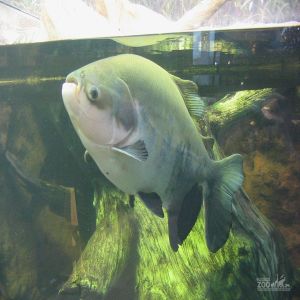 Pacu is a common name said to refer to several species of omnivorous freshwater fish that are related to the piranha. Pacu have square, straight teeth, which are similar to human teeth. They can reach a length of up to 3.5 feet and weigh about 88 pounds. Pacu can live up to about 20 years. They have not been classified by the IUCN at this moment.
Pacu is a common name said to refer to several species of omnivorous freshwater fish that are related to the piranha. Pacu have square, straight teeth, which are similar to human teeth. They can reach a length of up to 3.5 feet and weigh about 88 pounds. Pacu can live up to about 20 years. They have not been classified by the IUCN at this moment.
Location: Animals Formerly at Zoo
Share:
Range
Tropical and subtropical South America.
Habitat
They inhabit rivers, lakes, floodplains and flooded forests in the Amazon, Orinoco, Sao Francisco, and Rio de la Plata Basins as well as rivers in the Guianas. Pacus have become established in Puerto Rico and singles have been caught in numerous United States. The Amazon River is experiencing a crisis of overfishing. Both subsistence fishers and their commercial rivals compete in netting large quantities of pacus, which bring good prices at markets in Brazil and abroad.
Conservation Status
Primary Threats
Gestation
Spawning usually take place in 48 hours to a few days. The eggs are quite sticky and will adhere to foliage as they are dropped. The eggs hatch quickly, usually in about 36 hours.
Litter
The number of eggs has not been accurately determined, could be hundreds.
Behavior
Pacus are not social in nature. They can become increasingly independent and territorial as they grow. Pacu are not inhibited by tank size if sold to a customer and therefore many are released into rivers and lakes when they grow to a larger size than the owner wants. Pacus can survive in American rivers and are considered invasive in many states. Needing a lot of food to sustain their size they squeeze out indigenous species.
Reproduction
After mating, the parents go their separate ways, allowing the eggs to hatch on their own and the young fend for themselves.
Wild Diet
With their powerful jaw system they can crush seeds and nuts as well as any vegetation presented to them.
Zoo Diet

